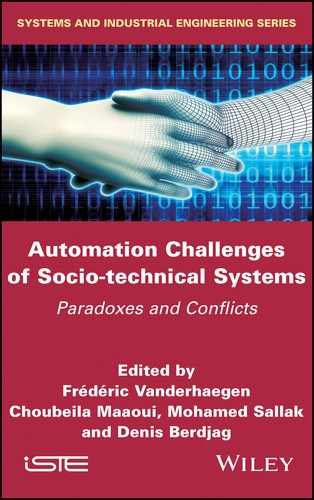Conclusion
For or against the automation of sociotechnical systems? The debate is not settled because it depends heavily on the assumptions that each side advocates for. However, this book has offered a relevant inventory of the different points of view regarding automation. First of all, as human capabilities are limited, the study of the perceptive senses is essential to know the optimal or failing interaction contexts between humans and machines. Shared control or authority sharing makes it possible to combine human and technical skills in order to optimize the performance of a system and to facilitate the understanding of every decision-maker regarding the current situation and its treatment. Therefore, technical interaction support must be defined in order to guarantee this facilitation regardless of the operational context. In order to achieve such a goal, behavioral or decisional models are needed for identifying and dealing with technical failure or human errors, for instance, or for optimizing decision support. This book has offered a few of them. Finally, the last chapters of this book offered different examples of innovation in cooperative crisis management configurations or during the collective performance of pedagogical exercises.
Will the machine replace humans and impose decisions on them without them being able to take part, or with the possibility of interacting but under certain conditions? Regardless of the field of application, the degrees of automation to be implemented recommend human actions in case of failure in the technical system. This assumes that human actors remain vigilant and attentive throughout the duration of an operation, or that their attention can be solicited by the activation of adequate alarms. Moreover, even though system automation can be justified by the number of accidents caused by human errors, no statistics exist on the rate of accidents or disasters avoided thanks to human intervention!
Therefore, it is the position and the role of humans in sociotechnical systems that remains one of the central points of discussion and provokes divergences: their capacity to innovate and to create new systems, to cooperate with them, to use them and to modify or adapt them. However, while these capacities are variable and can be temporarily or permanently limited, automation makes it possible to increase them. The concept of the augmented human is still a challenge for acknowledging such variability. However, it would be a mistake to design technical systems without taking advantage of human intelligence. Thus, the concept of augmented or assisted automation could be developed in order to perfect the symbiosis between humans and machines, without implying alienation or servitude.
The imagination or creativity of human operators sometimes enables them to define new unforeseen uses or to deflect the initial functions of technical systems. It would be interesting to think about the characteristics and the implementation of this innovation capability in machines and to wonder whether these could, by themselves, invent new uses or create new modes of interaction, or even make scientific discoveries!
This book has shown to what extent the demonstration of symbiosis between humans and machines is difficult to implement and to sustain in the short, medium or long term. It has opened interesting perspectives for achieving such a fusion, which requires skills related to cognitive, engineering and social sciences.
Conclusion written by Frédéric VANDERHAEGEN, Choubeila MAAOUI, Mohamed SALLAK and Denis BERDJAG.
